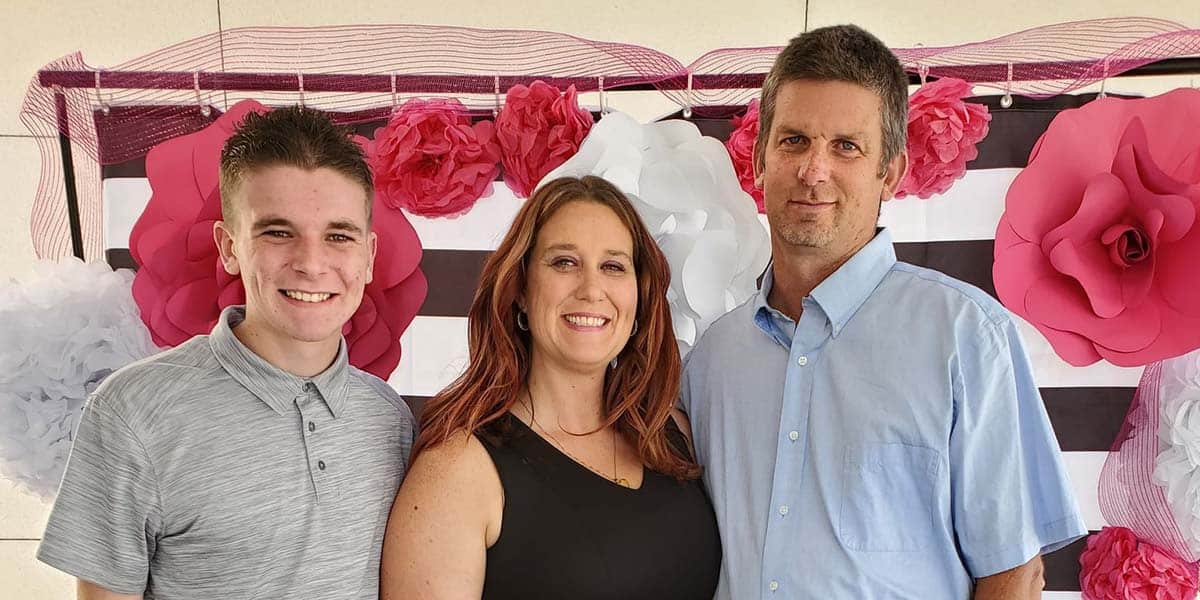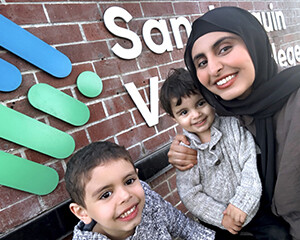Medical Assistant career not on radar until SJVC campus visit

Jennifer Yarbrough was not one of those kids who grew up knowing they wanted to one day work in the medical field. Far from it. After completing high school, she spent a few years teaching cake decorating, kids’ crafts and scheduling classes for painting instructors.
When her son Aaron was born, she and husband Matt decided she would be a stay-at-home mom for a few years. Ten years flew by. When it was time to re-enter the workforce, Jennifer had some ideas…and requirements. “I wanted to work Monday-Friday, 8:00 to 5:00,” she decided. She began her job search.
Jennifer noticed something about popular career fields right away. “Looking for different jobs, there were a lot of openings for Medical Assistants.” Unfortunately, she had no medical training. “I researched different schools for a medical program and other ones (than SJVC) were a lottery as to whether you could get in.” She knew a couple of people who had gone to SJVC’s Medical Assisting program on the Visalia campus, so she looked in that direction.
When she realized that SJVC also had a campus closer to her in Hanford, she opted to explore that possibility. “I liked how small it was and everyone seemed to be real friendly,” Jennifer remembers. “I liked the smaller campus because it’s a little more intimate and you can kind of get to know everybody.”
Matt and Aaron were with her for the tour and supported whatever direction she chose. “I decided I was going to go and take the Clinical Medical Assistant program test (entrance exam),” says Jennifer. “I knew I was going out on a limb because I was not eligible for any financial aid.”
Everything fell into place and in no time, Jennifer was ready to take her seat in the Clinical Medical Assisting program’s classroom where, at age thirty-six, most of her fellow students were younger. “I wasn’t sure what I was getting into or what I was going to be doing,” she says. But she knew she had lots of support at home.
“I tried to balance it all, but sometimes I would get discouraged,” she remembers. “They (Matt and Aaron) would help me with things like doing easy crockpot meals and told me not to worry about things like that.” It was a group effort.
Her greater challenges were academic. “When something wasn’t clicking (in her program) or I didn’t understand the process of something, I’d feel like I was failing.”
The classroom could be intimidating. “Our first mod (module) was learning how to set up trays for procedures in a medical office: taking BP/vitals, doing EKGs – it was a lot,” says Jennifer. “It was also a lot to go from not being in school for 16-years, then jumping in head-first!”
It helped that there was a weekly system she could count on. “We were given assignments on Monday to be ready for a quiz on Friday,” she says. “Flash cards were my best friends and I bought them 300 at a time.”
Jennifer and Aaron often studied together in the evenings. “At fifteen he was pretty supportive, and he was excited about me going to school.” He was also a willing practice partner. “I used him as my person to do blood-pressure on each night, and he got it taken a lot,” she says. “If he had been a little bit older, I would have used him as a pin cushion, too (venipuncture and blood draws).” Matt drew the short straw on that one. “I got him on the first try – he has really good veins.” Matt also often quizzed her with the flash cards.
Jennifer had another support team at school. “Sometimes it was hard to understand all the things for the front office (medical front office protocol),” she says. “But with help from some of the teachers, like Mrs. Avina, who was really good at explaining something in a different terminology, I could understand it better. She was also a very good mentor. Another faculty member stands out to her. Ms. Gibson has that mother-like personality that when you’re feeling overwhelmed, she will help you through it.”
The hands-on parts of becoming a Medical Assistant had great appeal to Jennifer. “My favorite was EKGs – that was my fun thing that I did. It was interesting how you could stick little stickers on someone, and the wires read the heart rate. It tests for previous heart attack, checks rhythm of the heart; sometimes your heart may skip or flutter.”
Jennifer was less intrigued by venipuncture and blood draws. “I was fearful with that. At first, I was terrified of poking someone with a needle and not hitting the right spot and having to poke them again. But I did it pretty well.”
In fact, much of Jennifer’s anxiety left after the first couple of weeks. “After just a couple of chapters everything was easier to memorize and easier to understand,” she says. “There were still times I would stress really badly over a test, not feeling confident, then would take the test and get 100%.”
Jennifer earned a 4.0 GPA, spot on the Dean’s List and Perfect Attendance.
She felt motivated to share the confidence she had found with other students who might struggle. “When I first started, I was not really a get-up-in-front-of everybody kind of person,” says Jennifer. But she joined the Associate Student Body (ASB) and as President went to classrooms to make announcements about school activities. “It taught me to be on the spot and speak in front of people and not have a script.”
She would also address new students at their school Orientation. “I would tell them how it was to balance school and home life and let them know about what goes on on campus. I’d let them know that their teachers were really there for them when they needed help with something.”
Jennifer made sure incoming students knew about all the fun and professional training experiences that lay ahead. “At the Hanford campus we would always have different activities going on like bake sales, pizza or hot dog days, hot chocolate or cookie sales. We had Professional Dress Day where you would wear what you would wear to go to work or to a job interview. The Dean or Career Services or an instructor would pull us out one-by-one and do a job interview. You would act like you were going to a regular interview: handshake, eye contact, professional dress. And they would critique you on what to fix for future actual interviews.”
As a volunteer mentor and speaker at Orientations Jennifer had a lot of good advice to pass along to new students. “One of the most important things I always told them was not to wait until Thursday to do the work due by noon on Friday.” That one-day scramble can come to a stressful end.
She also reminds new students that SJVC’s faculty makes every effort to support their success. “The teachers that I’ve had at SJVC are kind of the backbone to your education, and they’re always there whenever you need anything,” Jennifer told them.
“Jennifer was an amazing and dedicated student,” says Cari Stockdale, Academic Dean and Dean of Student Services. “She was in our ASB and as the President she would always talk to new students at Orientation, share her story and tell them to stay committed because giving up should not be an option.”
Jennifer completed her Clinical Medical Assisting program in March and successfully passed her certification exam. “Ok, I think I got this!” she realized.
That same month Jennifer went to work for a local cardiologist where she put all she learned in her CMA studies and hands-on practice into her work. It proved to be a good fit.
Jennifer’s long-term vision might invite further tweaking. “I will say that in the long run, I want to teach Medical Assisting. In order to teach I would have to go back to school at some time and get a degree. But this field work experience does help you to be able to go in there and teach it.”
She might one day find herself in a familiar place. “I love the school (SJVC). I could see myself being part of that.”
The footsteps of her past mentors should prove to be a comfortable path to follow.
Learn More About A Career In Medical Assisting
Whether you have always wanted to work in the medical field or you’re realizing a new passion for medicine, continue reading to learn more about what a medical assistant does, how to become one, how to choose a Medical Assisting program and California’s state-specific requirements for certification.
You might also like
More stories about
Request Information
All fields using an asterik (*) are required.


